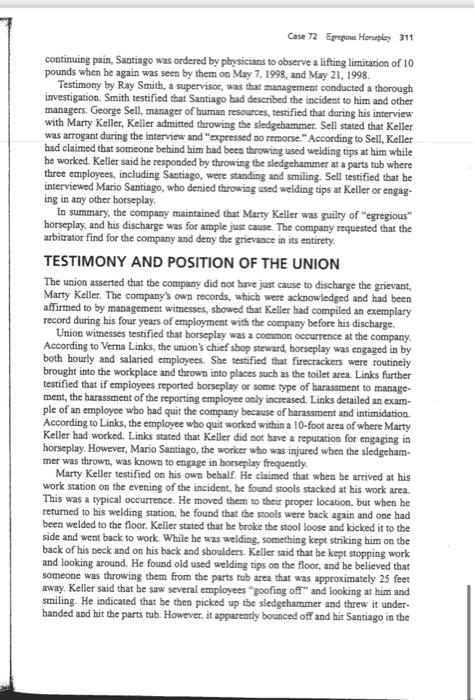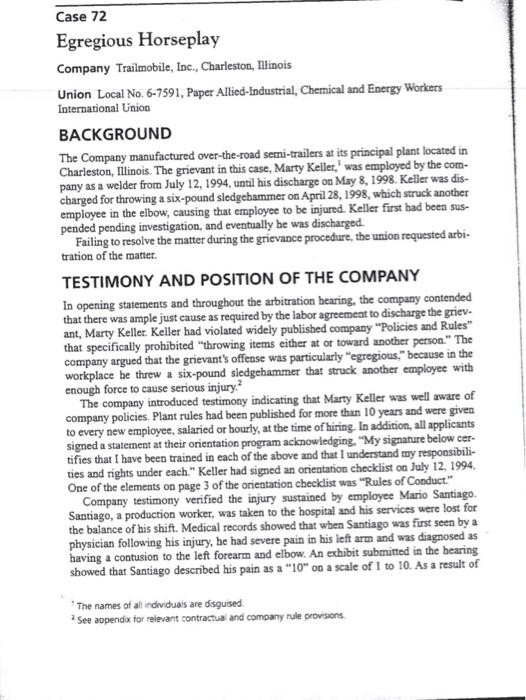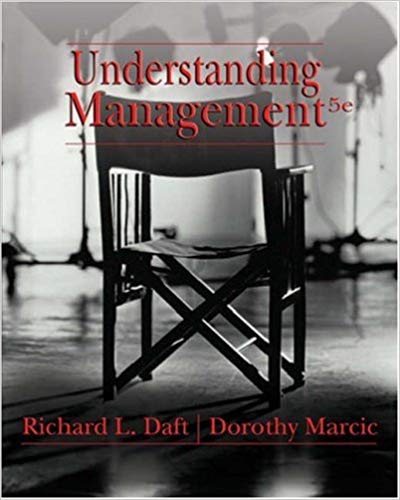Determine who winseither Grievance Denied or Grievance Upheld.
Write an opinion which explains your award to either side.
Identify the issues that were in dispute, (what youre deciding as an arbitrator).
Briefly summary each side (union and management), arguments regarding the dispute.
Analyze the facts, arguments, and contract language to establish the basis of your decision regarding the case.

Case 72 Eyregou Horspley 311 continuing pain, Santiago was ordered by ptrysicians to observe a lifting limitation of 10 pounds when he again was seen by them on May 7, 1998, and May 21, 1998. Testimony by Ray Smith, a supervisor, was that management conducted a thorough imvestigation. Smith testified that Santiago had described the incident to him and other managers. George Sell, manager of human resources, testified that during his interview with Marty Keller, Keller admitted throwing the sledgebammer. Sell stated that Keller was arrogant during the interview and "expressed no rermorse." According to Sell, Keller had claimed that someone behind him bad been throwing used welding tips at him while he worked. Keller said he responded by throwing the sledgehammer at a parts tub where three employees, including Santiago, were standing and smiling. Sell testified that be interviewed Mario Santiago, who denied throwing used welding tips at Keller or engaging in any other horseplay. In summary, the company maintained that Marty Keller was guitty of "egregious" horseplay, and his discharge was for ample just cause. The company requested that the arbitrator find for the company and deny the grievance in its entirety. TESTIMONY AND POSITION OF THE UNION The union asserted that the company did not have jast cause to discharge the grievant, Marty Keller. The company's own records, which were acknowledged and had been affirmed to by management witnesses, showed that Keller had compiled an exemplary record during his four years of employment with the company before his discharge. Union witnesses testified that borsepiay was a common occurrence at the company. According to Vema Links, the uinion's chief shop steward, horseplay was engaged in by. both hourly and salaried employees. She testified that firecracicers were routinely brought into the workplace and thrown into places such as the toilet area. Links further testified that if employees reported borseplay or some type of harssment to management, the harassment of the reporting employee only incteased. Links detalled an example of an employee who had quit the company because of barassment and intimidation. According to Links, the employee who quit worked within a 10-foot area of where Marty Keller had worked. Links stated that Keller did not have a reputation for eagaging in horseplay. However, Mario Santiago, the worker who was injured when the sledgehammer was thrown, was known to engage in horseplay fregaently. Marty Keller testified on his own behalf. He claimed that when he arrived at his work station on the evening of the incident, he found stools stacked at his work, area. This was a typieal occurrence. He moved them no their proper location, but when he retumed to his weiding station, he found that the snools were back again and one had been welded to the floor. Keller stated that be broke the stool loose and kicked it to the side and went back to work. While he was welding, something kept striking him on the back of his neck and on his back and shoulders. Keller said that he kept stopping work and looking around. He found old used welding tips on the floor, and be believed that someone was throwing them from the parts tub area that was approximately 25 feet away. Keller said that be saw several employees "goofing off" and looking at him and smiling. He indicated that he then picked up the sledgehammer and threw it underhanded and hit the parts tub. However, it appareatly bounced off and hit Saatiago in the Case 72 Egregious Horseplay Company Trailmobile, Inc., Charleston, Illinois Union Local No. 6-7591, Paper Allied-Industrial, Chemical and Energy Workers International Union BACKGROUND The Company manufactured over-the-road semi-trailers at its principal plant located in Charleston, Illinois. The grievant in this case, Marty Keller,' was employed by the company as a welder from July 12,1994 , until his discharge on May 8, 1998. Keller was discharged for throwing a six-pound sledgebarmmer on April 28, 1998, which struck another employee in the elbow, causing that employee to be injured. Keller first had been suspended pending investigation, and eventually he was discharged. Failing to resolve the matter during the grievance procedure, the union requested arbitration of the matter. TESTIMONY AND POSITION OF THE COMPANY In opening statements and throughour the arbitration bearing, the company contended that there was ample just cause as required by the labor agreement to discharge the grievant, Marty Keller. Keiler had violated widely published company "Policies and Rules" that specifically prohibited "throwing items either at or toward another person." The company argued that the grievant's offense was particularly "egregious," because in the workplace be threw a six-pound sledgehammer that struck another employee with enough force to cause serious injury. 2 The company introduced testimony indicating that Marty Keller was well aware of company policies. Plant rules had been published for more than 10 years and were given to every new employee, salaried or hourly, at the time of hiring. In addition, all applicants signed a statement at their orientation program acknowledging, "My signature below certifies that I have been trained in each of the above and that I understand my responsibilities and rights under each." Keller had signed an orientation checkiist on July 12, 1994. One of the elements on page 3 of the orientation checklist was "Rules of Conduct." Company testimony verified the injury sustained by employee Mario Santiago. Santiago, a production worker, was taken to the hospital and his services were lost for the balance of his shift. Medical records showed that when Santiago was furst seen by a physician following his injury, be had severe pain in his left arm and was diagnosed as baving a contusion to the left forearm and elbow. An exbibit submitted in the bearing showed that Santiago described his pain as a "10" on a scale of 1 to 10 . As a result of








